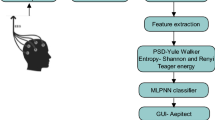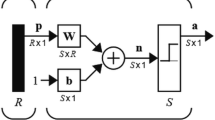Abstract
Epilepsy is a disorder of cortical excitability and still an important medical problem. The correct diagnosis of a patient’s epilepsy syndrome clarifies the choice of drug treatment and also allows an accurate assessment of prognosis in many cases. The aim of this study is to evaluate epileptic patients and classify epilepsy groups by using Multi-Layer Perceptron Neural Networks (MLPNNs). 418 patients with epilepsy diagnoses according to International League against Epilepsy (ILAE, 1981) were included in this study. The correct classification of this data was performed by two expert neurologists before they were executed by MLPNNs. The MLPNNs were trained by the parameters obtained from the EEG signals and clinic properties of the patients. We classified the epilepsy into two groups such as partial and primary generalized epilepsy and we achieved an 89.2% correct prediction rate by using MLPNN model. The parameters of the loss of consciousness in the course of seizure, the duration and ritmicity of abnormal activities found in EEG constituted the most significant variables in the classification of epilepsy by using MLPNN. These results indicate that the classification performance of MLPNN model for epilepsy groups is satisfactory and we think that this model may be used in clinical studies as a decision support tool to confirm the classification of epilepsy groups after they are developed.
Access this chapter
Tax calculation will be finalised at checkout
Purchases are for personal use only
Preview
Unable to display preview. Download preview PDF.
Similar content being viewed by others
References
Pedley, T.A., Mendiratta, A., Walczak, T.S.: Seizures and epilepsy. In: Ebersole, J.S., Pedley, T.A. (eds.) Current Practice of Clinical Electroencephalography, pp. 506–587. Lippincott Williams & Wilkins Comp., USA (2002)
Smith, S.J.M.: EEG in neurological conditions other than epilepsy: When does it help, what does it add? J. Neurol. Neurosurg. Psychiatry 76, 8–12 (2005)
Smith, S.J.M.: EEG in diagnosis, classification, and management of patients with epilepsy. J. Neurol. Neurosurg. Psychiatry 76, 2–7 (2005)
King, M.A., Newton, M.R., Jackson, G.D., et al.: Epileptology of the first -seizure presentation: a clinical, electroencephalographic and magnetic resonance imaging study of 300 consecutive patients. Lancet 352, 1007–1011 (1998)
Trescher, H.W., Lesser, R.P.: The Epilepsies. In: Bradley, G.W., Daroff, B.R. (eds.) Neurology in Clinical Practice, pp. 1745–1779. Buterworth-Heineman, USA (2000)
Kiloh, L.G., McComas, A.J., Osselton, J.W.: Clinical Electroencephalography, pp. 168–200. Butterworht & Co ltd., Great Britain (1972)
Selvi, S.T., Arumugam, S., Ganesan, L.: BIONET: An artificial neural network model for diagnosis of diseases. Pattern Recognition Letters 21, 721–740 (2001)
Tomida, S., Hanai, T., Koma, N., Suzuki, Y., Kobayashi, T., Honda, H.: Artificial neural network predictive model for allergic disease using neural network nucleotide polymorphisms data. Journal of Bioscience and Bioengineering 93(5), 470–478 (2002)
Zhang, G.P., Berardi, V.L.: An investigation of neural networks in thyroid function diagnosis. Health Care Management Science 1, 29–37 (1998)
Itchhaaporia, D., Snow, P.B., Almassy, R.J., Oetgen, W.J.: Artificial neural networks: current status in cardiovascular medicine. JACC 28(2), 515–521 (1996)
Abe, H., Ashizawa, K., Li, F., Matsuyama, N., Fukushima, A., Shiraishi, J., Macmahon, H., Dio, K.: Artificial neural networks for differential diagnosis of interstitial lung disease: results of a simulation test with actual clinical cases. Acad Radiol 11, 29–37 (2004)
Webber, W.R.S., Lesser, R.P., Richardson, R.T., Wilson, K.: An approach to seizure detection using an artificial neural network. Electroencephalography and Clinical Neurophysiology 98, 250–272 (1996)
Pradhan, N., Sadasivan, P.K., Arunodaya, G.R.: Detection of seizure activity in EEG by artificial neural network: A preliminary study. Computers and Biomedical Research 29, 303–313 (1996)
Gabor, A.J.: Seizure detection using a self-organizing neural network: validation and comparison with other detection strategies. Electroencephalography and Clinical Neurophysiology 107, 27–32 (1998)
Walczak, S., Nowack, W.J.: An artificial neural network to diagnosing epilepsy using lateralized burst of theta EEGs. Journal of Medical Systems 25(1), 9–20 (2001)
Subasi, A., Ercelebi, E.: Classification of EEG signals using neural network and logistic regression. Computer Methods and Programs in Biomedicine 78, 87–99 (2005)
Alkan, A., Koklukaya, E., Subasi, A.: Automatic seizure detection in EEG using logistic regression and artificial neural network. Journal of Neuroscience Methods 148, 167–176 (2005)
Guler, I., Ubeyli, E.D.: Adaptive neuro-fuzzy inference system for classification of EEG signals using wavelet coefficients. Journal of Neuroscience Methods 48(2), 113–121 (2005)
Kellaway, P.: Orderly approach to visual analysis: Elements of the normal EEG and their characteristics in children and adults. In: Ebersole, J.S., Pedley, T.A. (eds.) Current practice of clinical electroencephalography, pp. 100–159. Lippincott Williams & Wilkins, Philadelphia (2002)
Haykin, S.: Neural Networks: A Comprehensive Foundation. Macmillan, New York (1994)
Bernand, E.: Optimization training neural nets. IEEE Trans. Neural Networks 3(2), 989–993 (1992)
Hagan, M.T., Menhaj, M.B.: Training feedforward networks with the Marquardt algorithm. IEEE Trans. Neural Networks 5(6), 989–993 (1994)
Wilamowki, B.M., Iqlikci, S., Kaynak, O., Onder, E.M.: An algorithm for fast converges in training neural networks. In: IEEE Proceedings of International Joint Conference on Neural Networks, pp. 1778–1782 (2005)
Lera, G., Pinzolas, M.: A quasi-local Levenberg-Marquardt algorithm for neural network training. IEEE World Congress on Computational Intelligence 3, 2242–2246 (1998)
Manolis, I.A.L., Antonis, A.A.: Is Levenberg-Marquardt the most efficient optimization algorithm for implementing bundle adjustment? IEEE Proceedings of International Conference on Computer Vision 2, 1526–1531 (2005)
Gaafar, L.K., Choueiki, M.H.A.: Neural network model for solving the lot sizing problem. The International Journal of Management Science 28, 175–184 (1999)
Hopkins, A., Garman, A., Clarke, C.: The first seizure in adult life. Value of clinical features, electroencephalography, and computerized tomographic scannig in prediction of seizure recurrence. Lancet 1, 721–726 (1988)
Drake, M.E., Padamadan, H., Newll, A.S.: Interictal quantitative EEG in epilepsy. Seizure 7, 39–42 (1998)
So, M.G., Thiele, A.E., Sanger, T., et al.: Electroencephalogram and clinical facilities in juvenile myoclonic epilepsy. J. Child Neurol. 13, 541–545 (1998)
Grünewald, R.A., Chroni, E., Panayiotopoulos, P.P.: Delayed diagnosis of juvenile myoclonic epilepsy. J. Neurol. Neurosurg. Psychiatry 55, 487–490 (1992)
Author information
Authors and Affiliations
Editor information
Rights and permissions
Copyright information
© 2007 Springer-Verlag Berlin Heidelberg
About this paper
Cite this paper
Sahin, C., Ogulata, S.N., Aslan, K., Bozdemir, H. (2007). The Application of Neural Networks in Classification of Epilepsy Using EEG Signals. In: Mele, F., Ramella, G., Santillo, S., Ventriglia, F. (eds) Advances in Brain, Vision, and Artificial Intelligence. BVAI 2007. Lecture Notes in Computer Science, vol 4729. Springer, Berlin, Heidelberg. https://doi.org/10.1007/978-3-540-75555-5_48
Download citation
DOI: https://doi.org/10.1007/978-3-540-75555-5_48
Publisher Name: Springer, Berlin, Heidelberg
Print ISBN: 978-3-540-75554-8
Online ISBN: 978-3-540-75555-5
eBook Packages: Computer ScienceComputer Science (R0)




